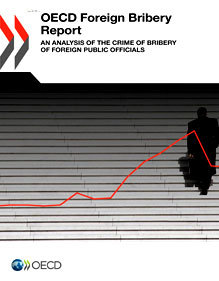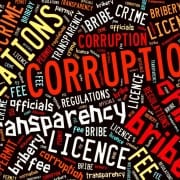|
Getting your Trinity Audio player ready...
|
 “In order to fight corruption and win, we have to know our enemy,” reads the introduction to the Organisation for Economic Co-operation and Development's (OECD) inaugural report on foreign bribery, released on 2 December. “Until now, there have been very few successful attempts to measure this complex and covert crime. We have been fighting in the dark.”
“In order to fight corruption and win, we have to know our enemy,” reads the introduction to the Organisation for Economic Co-operation and Development's (OECD) inaugural report on foreign bribery, released on 2 December. “Until now, there have been very few successful attempts to measure this complex and covert crime. We have been fighting in the dark.”
This is because corruption often takes place away from the public eye, and its proceeds are masked through offshore transactions, multiple intermediaries and complex corporate structures. This means that it takes extra effort, time, expertise and co-operation to detect, investigate and punish foreign bribery.
According to the organisation, the report aims to “measure, and to describe, transnational corruption based on data from the 427 foreign bribery cases that have been concluded since the entry into force of the OECD Anti-Bribery Convention in 1999.”
South Africa was not involved in any of those 427 cases – on the contrary, the OECD says the country is falling behind in its obligations to the convention. In a report released in March 2014 the OECD’s working group on bribery said it was “seriously concerned with the lack of foreign bribery enforcement actions in South Africa. Despite South Africa’s economic links to a number of countries with corruption risks, only ten foreign bribery allegations have surfaced since it became a party to the convention in 2007 – these allegations have not resulted in a single prosecution and the four on-going investigations are far from reaching the prosecutorial stage.”
Yet, says the foreign bribery report, bribes are being paid “across sectors to officials from countries at all stages of economic development.”
In the process, everyone is losing out. “The true social cost of corruption cannot be measured by the amount of bribes paid or even the amount of state property stolen. Rather, it is the loss of output due to the misallocation of resources, distortions of incentives and other inefficiencies caused by corruption that represent its real cost to society.”
Big shots can’t claim ignorance
The 427 cases in question comprised 263 against individuals and 164 against entities.
The report found four sectors that seemed to attract the bulk of illegal activity – the extractive (19%), construction (15%), transport and storage (15%), and information and communication sectors (10%).
Corporate leadership was found to be complicit in 41% of cases, where management-level employees paid or authorised the bribe. The company CEO was involved in 12% of cases, the OECD found. This negates the oft-claimed situation of employees acting independently.
Intermediaries were used in 76% of cases – some were individuals, but others were entities such as subsidiary companies, companies located in offshore financial centres or tax havens, or companies established under the beneficial ownership of the public official who received the bribes.
Global anti-corruption organisation Transparency International (TI) is currently promoting a campaign – Unmask the Corrupt – that targets this exact situation and calls for transparency in company business dealings.
“All you need is a secret company – or shell company – where the name of the real owner is hidden. It takes just 10 minutes, an internet connection and a credit card to get started, no questions asked and once the secret company is set up, you can open bank accounts,” says TI.
The OECD report also found that in more than half of the cases, bribes were paid to get a contract for public procurement, while 27% of the bribe recipients were employees of state-owned enterprises. Next in line were customs officials (11%), health officials (7%) and defence officials (6%). South Africa is not immune to these scenarios.
Besides the 57% of cases where bribes were used to secure contracts, they were also used to bypass customs procedures in 12% of cases, while 6% of bribes were used to gain preferential tax treatment.
“With bribes averaging 10.9% of the total transaction value, and combined monetary sanctions ranging from 100 to 200% of the proceeds of the corrupt transaction in 41% of cases, the business case against corruption is clear,” says the report.
Read the OECD Foreign Bribery report online.
What to do?
According to OECD secretary-general Angel Gurría, the prevention of business crime should be at the centre of corporate governance. Gurria is also of the opinion that corruption is a major stumbling block to growth and development, and that the corrupt must be brought to justice. “At the same time, public procurement needs to become synonymous with integrity, transparency and accountability.”
Speaking at the launch of the report last week, Gurria named several measures identified by the OECD that could help public authorities to be more effective in rooting out bribery. He called on the leaders of the OECD working group on bribery’s 41 member countries, as well as those of the G20, to lead by example and prosecute corruption. In South Africa’s case, its incumbent president Jacob Zuma has himself been embroiled in several corruption-related scandals, and has twice escaped prosecution on corruption charges.
Gurria also said that secret corporate dealings have to be exposed, so that beneficiaries of corruption will no longer have a place to hide.
“We will work with our members to support implementation of the G20 high-level principles on beneficial ownership transparency, including, for example, the creation of central registries of beneficial ownership of legal persons,” he added.
Public authorities and businesses must do more to ensure integrity, transparency and accountability in public procurement, Gurria said, and emphasised that those who ask for bribes should not be neglected when it comes to meting out justice.








